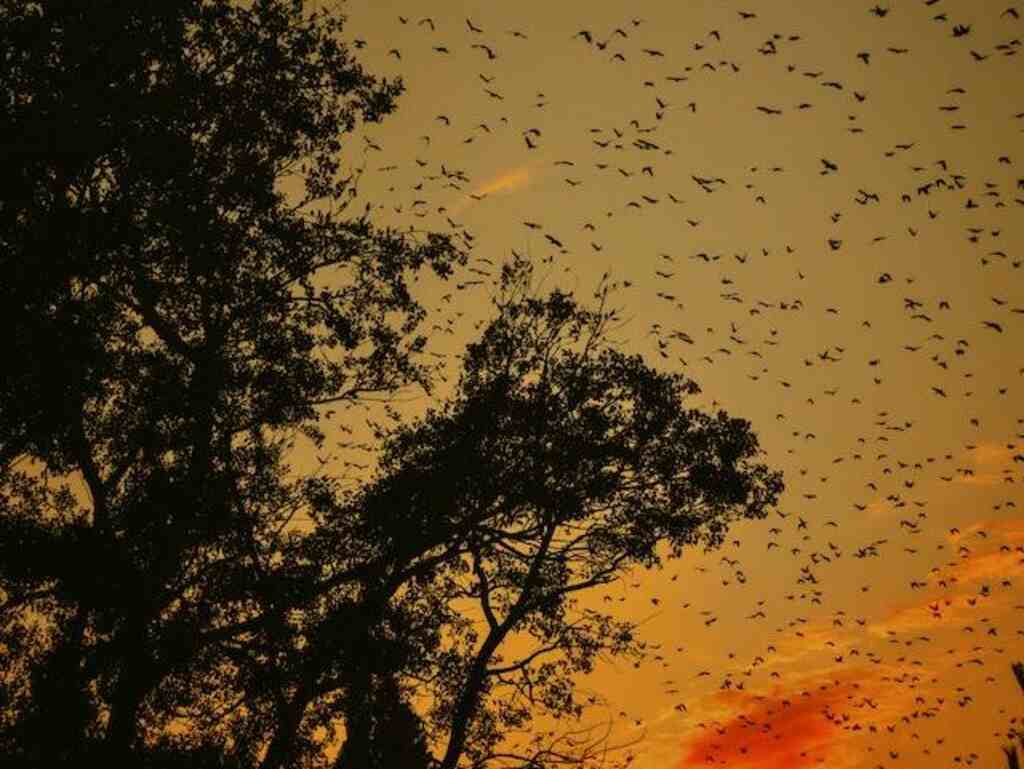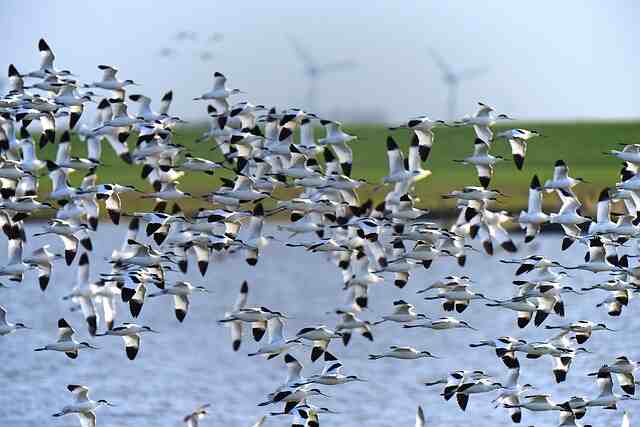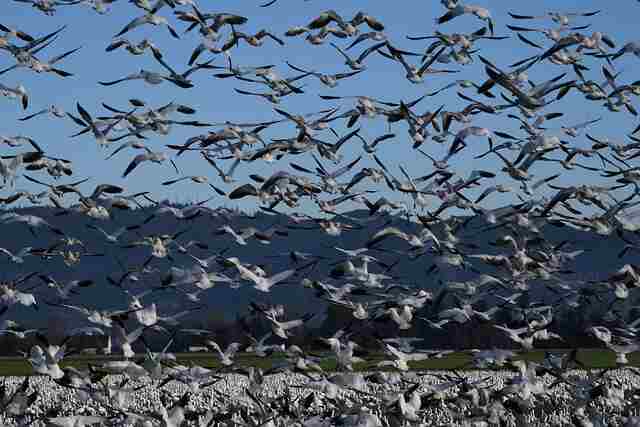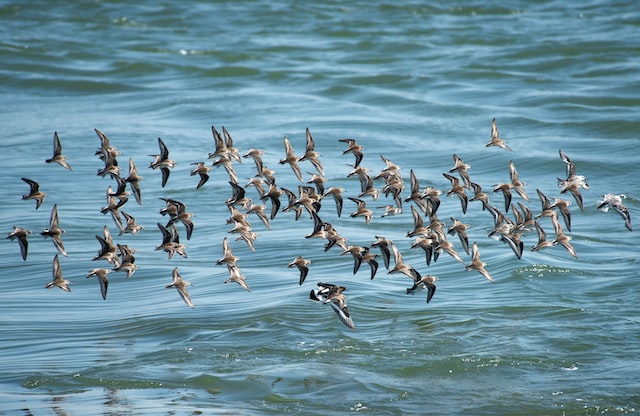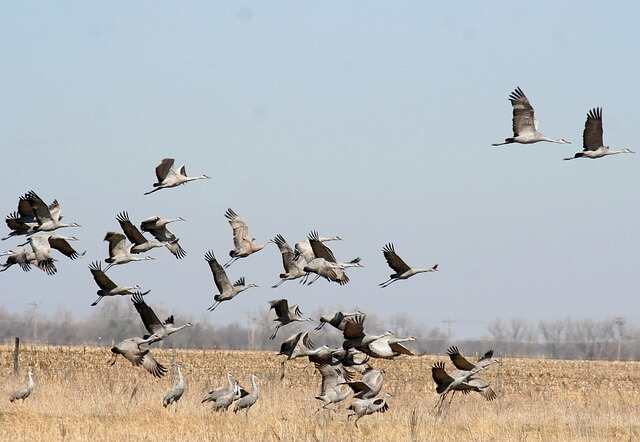Bird migration patterns are fascinating phenomena that have intrigued scientists and bird enthusiasts for centuries. These patterns are unique to each species and are influenced by a variety of factors such as breeding habits, climate conditions, and food availability.
Understanding bird migration patterns is crucial for bird conservation and for gaining insight into the behaviors and adaptations of different bird species. In this article, we will explore the different types of bird migration patterns, their characteristics, and the factors that influence them.
Table of Contents
- 1 Why Do Birds Migrate?
- 2 Migration Distances
- 3 What to look for in a Migration Season?
- 4 Top Destinations for Bird Migration Season
- 5 Tips for Planning Your Migration Season
- 6 Frequently Asked Questions
- 6.1 What is the best time of day to go birdwatching during migration season?
- 6.2 Can I go birdwatching on my own, or do I need a guide?
- 6.3 What types of birds can I expect to see during migration season?
- 6.4 Is it safe to travel to these birdwatching destinations during migration season?
- 6.5 How can I contribute to bird conservation during my birdwatching trip?
- 7 Conclusion
- 8 Author
Why Do Birds Migrate?
The primary reason that birds migrate is to survive extreme weather conditions like cold winters or droughts. By leaving their habitat for more hospitable locations, they can ensure their survival during periods when resources become scarce.
Migration also allows them to access new areas where food sources are abundant. Many species of birds that live in colder climates will fly south for the winter months because insects, which make up a large part of their diet, cannot survive the cold temperatures.
Conversely, some migratory species from the Southern Hemisphere travel north during summer in order to breed and raise their young in cooler climates with more available resources.
Migration Distances
Long Distance Migration
Long distance migration is the regular seasonal movement of birds between their breeding and non-breeding areas, usually separated by thousands of kilometers. Birds undertake this journey to find favorable breeding and feeding conditions, escaping harsh weather, or to avoid competition for resources.
Migratory birds use various navigational tools to navigate, such as the earth’s magnetic field, celestial cues, and the sun’s position. The migration can be dangerous and challenging, with many birds facing the risk of predation, starvation, and exhaustion.
Nonetheless, migration is a critical part of bird biology and plays a significant role in shaping global bird populations. Some examples below.
- Arctic Tern: These birds migrate the longest distance of any bird, traveling from their breeding grounds in the Arctic to their wintering grounds in the Antarctic, covering a round trip of up to 25,000 miles. They do this to follow the summer season and to feed on krill and other small marine creatures.
- Bar-tailed Godwit: These birds breed in Alaska and Siberia and then migrate non-stop for over 8,000 miles to their wintering grounds in New Zealand and Australia. This incredible journey takes around eight days without any breaks and is the longest non-stop flight of any bird.
- Swainson’s Hawk: These birds breed in North America and then migrate to South America for the winter, covering a distance of up to 6,000 miles and 12,000 round-trip. During migration, they form kettles or groups to ride thermal currents, saving energy as they travel.
- Ruby-throated Hummingbird: These tiny birds breed in the eastern United States and then migrate across the Gulf of Mexico to spend the winter in Central America. They can fly non-stop for up to 22 hours and cover up to 500 miles in a single flight.
- Common Swift: These birds breed in Europe and then migrate to Africa for the winter, covering a distance of up to 14,000 miles. They spend almost their entire lives flying and can even sleep while in flight.
Medium/Short Distance Migration
Short distance migration in birds refers to the seasonal movement of birds over relatively short distances, typically within their breeding range or to nearby areas with more favorable conditions for survival. This type of migration is common in temperate and tropical regions where the climate varies seasonally.
Examples of short-distance migrants include many songbirds, waterfowl, and raptors, which move between breeding and wintering grounds that are often only a few hundred kilometers apart.
These migrations may also involve altitudinal movements, where birds move up or down mountains to find more suitable habitats. Some examples below.
- Blue Jay: Breeds in much of North America, and migrates to the southern United States for the winter. Known for their bold blue coloration and raucous calls.
- American Robin: Breeds in Canada and the northern United States, and migrates to the southern United States and Mexico for the winter. Known for their orange-red breast and melodious song.
- White-throated Sparrow: Breeds in Canada and the northeastern United States, and migrates to the southern United States for the winter. Known for their clear whistled song and distinctive white throat.
- Red-winged Blackbird: Breeds in much of North America, and migrates to the southern United States and Central America for the winter. Known for their distinctive red and yellow shoulder patches and gurgling song.
- Common Yellowthroat: Breeds in much of North America, and migrates to the southern United States and Central America for the winter. Known for their striking black mask and cheerful “witchety-witchety” call.
Nomadic/Irregular Migrants
Nomadic or irregular migration in birds refers to the behavior of some bird species that do not follow a regular migratory pattern. Instead, they move in response to environmental cues, such as food availability or weather patterns, and their movements may vary from year to year.
These birds do not have a fixed breeding or wintering ground, and their movements may be irregular and unpredictable. Examples of birds that exhibit nomadic or irregular migration include the waxwing, grosbeak, and crossbill.
This type of migration is less well understood than regular migration patterns and is an active area of research in ornithology. Some examples below.
- Snowy Owl: These birds are found in the Arctic during the breeding season, but during the winter they may migrate south to areas such as the northern United States and Europe in search of food.
- Common Redpoll: These small finches breed in the Arctic, but during the winter they may migrate southward in search of food. Their migration patterns can vary widely from year to year depending on food availability.
- Bohemian Waxwing: These birds breed in the boreal forests of Canada, but during the winter they may move southward in search of food. Their movements can be highly irregular and unpredictable.
- Cedar Waxwing: These birds are known for their distinctive crested head and black mask. While they are typically considered a resident species in much of their range, they may move southward in the winter in search of food.
- Pine Siskin: These small finches breed in the boreal forests of Canada and Alaska, but during some winters they may move southward in large numbers in search of food. The timing and extent of these irruptions can be highly variable from year to year.
Permanent Residents
Permanent residents are bird species that reside year-round within their breeding territories. Unlike migratory birds, permanent residents do not undertake long-distance seasonal movements in search of food, breeding grounds, or better climate conditions.
These birds have adapted to their local environments, surviving and thriving in a specific area throughout the year. Some examples of permanent resident bird species include the blue jay, black-capped chickadee, Northern cardinal, and American goldfinch.
These birds have stable populations and are well-suited to their local ecological conditions, enabling them to live and breed successfully in their respective habitats. Some examples below.
- American Crow: Found throughout most of North America year-round, these intelligent birds are known for their distinctive “caw-caw” call and adaptability to urban environments.
- Northern Cardinal: Found throughout the eastern United States year-round, these colorful birds are known for their bright red plumage and distinctive crest.
- Black-capped Chickadee: Found throughout much of North America year-round, these small birds are known for their acrobatic movements and cheerful “chick-a-dee-dee-dee” call.
- Downy Woodpecker: Found throughout much of North America year-round, these small but mighty birds are known for their distinctive black and white plumage and ability to excavate holes in trees.
- Mourning Dove: Found throughout much of North America year-round, these gentle birds are known for their soft cooing call and ability to survive in a wide range of habitats, including urban areas.
What to look for in a Migration Season?
Choosing a migration season birdwatching destination is crucial to maximizing your chances of seeing a diverse range of migratory birds. Weather and climate, habitat diversity and bird concentration, accessibility and infrastructure, and local birding community and resources are all vital factors to consider.
Weather and climate considerations
Diverse bird species have unique migration schedules that hinge on regional climate variations. To optimize birdwatching adventures, knowing the specific climate and weather patterns of the area during migration season is crucial.
Weather conditions can play a significant role in bird behavior, and when conditions are favorable, the likelihood of observing a greater number of birds increases.
With creativity and attention to detail, bird enthusiasts can enhance their chances of spotting the most captivating winged creatures during their migrations.
Habitat diversity and bird concentration
Diversity in habitats and ecological niches is a must for avid birdwatchers seeking the ultimate experience. Such a variety entices an array of bird species to take up residence, offering a perfect opportunity to observe diverse bird behaviors.
However, bird concentration is equally significant, for it elevates the odds of spotting various bird species in a single location. The best birdwatching destinations ensure both habitat diversity and bird concentration to guarantee an unforgettable birdwatching experience.
Accessibility and infrastructure
The accessibility and infrastructure of a birdwatching destination are vital components in ensuring an exceptional and satisfying birding experience. To fully enjoy the trip, one must consider the availability of basic necessities like lodging, food, and transportation.
Moreover, the ease of accessing birding sites and trails has a direct impact on the diversity of bird species you encounter. Thus, accessibility and infrastructure must be given great importance in planning your birdwatching adventure
Local birding community and resources
Unleash your inner birding enthusiast and soar into a world of abundant birding resources within the local community! From seasoned bird guides to exciting birding hotspots and exhilarating tours, there is no shortage of opportunities to witness the magic of migratory birdwatching.
With the locals’ encyclopedic knowledge and expertise, rare and elusive species are no longer out of reach. Prepare to broaden your understanding of bird behavior and deepen your connection to nature, all thanks to the vibrant birding community and resources available right at your fingertips.
Top Destinations for Bird Migration Season
North America
Cape May, New Jersey
Immerse yourself in the wonder of bird migration season by visiting one of the top destinations for birdwatching – Cape May, New Jersey. This location offers an unparalleled opportunity to witness a vast array of bird species, thanks to its diverse coastal habitats and woodlands.
With its reputation as a premier birding hotspot, Cape May is the place to be for bird enthusiasts seeking to experience the beauty and grandeur of these majestic creatures in their natural habitat. Come and be part of the vibrant and dynamic birding community in Cape May!
Hawk Mountain, Pennsylvania
Experience the thrill of birdwatching during migration season at the stunning Hawk Mountain in Pennsylvania, hailed as the “Raptor Capital of the World.” With its breathtaking views and diverse range of birds of prey such as hawks, eagles, and falcons, it’s a must-visit destination for avid birdwatchers.
Witness the remarkable sight of these majestic birds soaring through the skies, and marvel at their impressive hunting skills. Come and discover why Hawk Mountain is a top birdwatching destination for migration season.
Point Pelee, Ontario, Canada
Get ready for a burst of excitement as we unveil the top birdwatching destinations for the migration season. First on our list is Point Pelee in Ontario, Canada – a haven for bird enthusiasts.
Dubbed as the “songbird highway,” it’s the perfect spot to witness millions of colorful birds, including warblers and thrushes, as they make their way down south.
With its awe-inspiring natural beauty and diverse birdlife, this is a must-visit destination for any avid birder looking for an unforgettable experience.
Bosque del Apache, New Mexico
If you’re a bird enthusiast, you’ll want to flock to Bosque del Apache in New Mexico during migration season. The marshy landscape is a haven for sandhill cranes, snow geese, and a variety of ducks, providing an unparalleled birdwatching experience.
With thousands of birds congregating in one place, the burst of energy and creativity in the air is palpable. Don’t miss your chance to witness this incredible display of nature’s wonder.
High Island, Texas
Experience a birdwatching adventure like no other at High Island, Texas, where you can witness a stunning array of neotropical migrants and shorebirds. This quaint coastal town is bursting with life during migration season, making it one of the top destinations for birdwatchers.
Immerse yourself in the sights and sounds of these beautiful creatures as they make their journey across the globe. With a remarkable concentration of bird species, High Island is an absolute must-visit for any nature enthusiast.
South America
Manu National Park, Peru
Get ready to witness the stunning migration of over 1,000 bird species at Manu National Park in Peru! The region boasts diverse habitats, ranging from lush lowland rainforests to soaring Andean grasslands.
With such variety, you’re bound to spot some incredible avian species, each with their own unique bursts of color and song.
So grab your binoculars and prepare to be amazed by the incredible birdwatching opportunities at this top destination!
Galápagos Islands, Ecuador
Discover the ultimate birdwatching destinations for migration season. Witness the remarkable bird species at Galápagos Islands, Ecuador. Be awestruck by the majestic blue-footed booby and the elusive Galápagos penguin, found only in this region.
This is a rare and extraordinary experience that offers a one-of-a-kind opportunity to witness the beauty and diversity of the bird species.
Explore the unspoiled islands, and bask in the sheer magnificence of the winged wonders that grace these shores. Come, embark on a journey of a lifetime, and immerse yourself in the wondrous world of birdwatching.
Patagonia, Argentina
Discover the ultimate birdwatching destinations during migration season with Patagonia, Argentina topping the list. The vast expanse of this region provides diverse habitats ranging from grasslands to marshes and forests, attracting a multitude of bird species, including the majestic Andean condor and adorable Magellanic penguin.
Whether you’re a beginner or a seasoned birder, Patagonia offers an unforgettable experience with an array of avian wonders. So pack your binoculars, set your compass, and get ready to witness the awe-inspiring beauty of bird migration in Patagonia.
Costa Rica
Embark on a feathered adventure to Costa Rica, a haven for birdwatchers seeking an array of over 900 bird species during migration season. From the vibrant toucans to the elusive quetzals and dazzling hummingbirds, Costa Rica offers a birdwatching experience like no other.
Immerse yourself in the lush rainforests and explore the diverse terrain, all while discovering some of the world’s rarest bird species. Don’t miss out on this opportunity to witness the magic of bird migration in one of the top birdwatching destinations in the world.
Europe
Falsterbo, Sweden
Witness the spectacular annual migration of birds by visiting the top birdwatching destinations during the season. Falsterbo, Sweden, a charming town in southern Sweden, is a must-visit location for bird enthusiasts. With over 350 recorded bird species, the town serves as a crucial stopover for migratory birds.
The vibrant bursts of colors and chirping sounds of these feathered creatures create a memorable experience for visitors. Don’t miss the chance to witness this awe-inspiring event and add Falsterbo to your birdwatching bucket list.
Biebrza Marshes, Poland
Experience the ultimate birdwatching adventure during migration season at the Biebrza Marshes in Poland – Europe’s largest marshland. Observe over 250 species of birds, including the elusive and endangered aquatic warbler.
Immerse yourself in the pristine natural habitat, teeming with vibrant avian life, and discover the unique sounds and sights of these feathered creatures. Don’t miss out on this once-in-a-lifetime opportunity to witness the incredible migration spectacle at one of the top birdwatching destinations in the world.
Eilat, Israel
Take off on a thrilling journey to Eilat, Israel, a bird paradise situated at the crossroads of three continents. Be amazed by over 500 bird species, including rare sightings of the Sinai rosefinch and the rufous-tailed scrub robin.
With its unique location, Eilat is a hub for bird migration, offering an unparalleled experience for bird enthusiasts. Witness the captivating burst of colors and melodious sounds as you explore this top destination for birdwatching during migration season.
Doñana National Park, Spain
Discover the ultimate birdwatching experience during migration season at the stunning Doñana National Park in Spain.
A UNESCO World Heritage Site, this natural haven serves as a crucial stopover for a diverse range of feathered friends, boasting a staggering 300 bird species, from magnificent flamingos to the rare and endangered Spanish imperial eagle.
Immerse yourself in the beauty of nature, and witness a breathtaking display of birds in their natural habitat.
Tips for Planning Your Migration Season
To ensure a successful birdwatching trip during migration season, consider the following tips:
Best times to visit
Make the most of your migration season by following these creative tips for planning your trip. Start by researching the best times to visit your destination, as migration schedules vary depending on the region and species of bird.
Get into the spirit by taking advantage of the season’s unpredictable nature and plan your trip around the unique events and activities that are happening during that time. With some creativity and planning, your migration season adventure will be one to remember!
Essential gear and equipment
Amplify your migration adventure with these must-have essentials: a trusty pair of binoculars, a field guide to identify unique species, and comfortable yet protective footwear and clothing.
Maximize your experience by planning ahead and scouting out ideal locations to spot your feathered friends. Stay hydrated and energized with water and snacks, and consider using a birding app to track your sightings.
Bird identification resources
To start, arm yourself with bird identification resources such as field guides and online guides such as the Bird Migration Explorer by Audubon. Delve into the heroic journeys of over 450 bird species and the obstacles they overcome.
Learn more about the specific species you may encounter, migratory patterns in your area, and conservation efforts to support these feathered travelers. With these resources, you’ll be well-prepared to appreciate the wonder and beauty of migration season.
Local birding tours and guides
To make the most out of your migration season bird watching, why not try hiring a local guide or joining a tour? Not only can they help you spot a wider variety of bird species, but they can also provide insight on the best times and locations to view them.
Imagine the burst of excitement as you catch a glimpse of a rare bird species, all thanks to the expertise of a knowledgeable guide. So don’t hesitate to add some creativity and adventure to your migration season plans by enlisting the help of a local birding expert.
Eco-friendly birdwatching practices
As you gear up for your birdwatching adventure, make sure to follow eco-friendly practices that respect the birds and their habitats. Stick to designated trails and avoid disturbing the birds, allowing them to thrive in their natural environment.
To make your migration season unforgettable, try new routes and times of day, bring a variety of equipment, and collaborate with other birdwatchers for unique experiences.
Frequently Asked Questions
What is the best time of day to go birdwatching during migration season?
The ideal time for birdwatching during migration season is early morning or late afternoon, when birds are most active, making them easier to spot. But why stick to the norm? Mix up your birdwatching times and explore different habitats for the chance to discover new species and behaviors.
Stay open-minded and curious to make your birdwatching experience unforgettable, filled with excitement and wonder. So grab your binoculars and venture out to unleash your inner birdwatcher.
Can I go birdwatching on my own, or do I need a guide?
While birdwatching can be done independently, going with an experienced guide can enhance the experience. They can help identify species, offer insights into behavior, and navigate the best spots to find the feathered creatures.
However, going solo allows for freedom and solitude to appreciate the beauty of nature. Ultimately, it depends on your preference and level of expertise. Whether you choose to soar solo or fly with a guide, remember to bring binoculars and a sense of wonder.
What types of birds can I expect to see during migration season?
During migration season, the skies are bustling with a diverse array of birds! Keep your eyes peeled for majestic raptors like hawks and eagles, as well as colorful songbirds such as warblers and thrushes.
You might even catch a glimpse of rare migratory birds like sandhill cranes or white-faced ibises. With so many different species in motion, you never know what feathered friend might fly your way next!
Is it safe to travel to these birdwatching destinations during migration season?
Birdwatching destinations during migration season can be safe as long as one takes necessary precautions, and planning. It is recommended to wear protective gear such as hats, long-sleeved clothing, and mosquito repellent.
It’s also essential to be aware of potential hazards like venomous snakes and poisonous plants. However, the rewards of witnessing the beauty of migrating birds in their natural habitat far outweigh any risks.
So pack your binoculars, grab your camera, and embark on an adventure that is both exciting and safe. Happy birding!
How can I contribute to bird conservation during my birdwatching trip?
As a birdwatcher, you have the unique opportunity to contribute to bird conservation during your trips by sharing your observations with citizen science programs like eBird and BirdTrack.
Additionally, you can support conservation organizations by donating or volunteering your time and resources. Take it a step further by learning about threats to bird populations and advocating for policies that protect them.
By combining your passion for birdwatching with conservation efforts, you can make a meaningful impact in protecting our feathered friends.
Conclusion
Recap of the importance of choosing the right birdwatching destination for migration season Final thoughts on the top birdwatching destinations and tips for planning a successful trip, Encouragement to continue exploring the amazing world of birdwatching during migration season.
Related Post:

